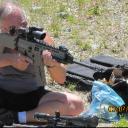Yahoo Answers is shutting down on May 4th, 2021 (Eastern Time) and the Yahoo Answers website is now in read-only mode. There will be no changes to other Yahoo properties or services, or your Yahoo account. You can find more information about the Yahoo Answers shutdown and how to download your data on this help page.
Trending News
Gun Cleaning Quandary...?
I am VERY OCD when it comes to cleaning my guns. I want them looking **** and span for the next outing and well oiled.
For best results and a better clean, I'd like to enlist the help of fellow gunman by getting your opinion on the following questions:
1) Bore Snake or Cleaning Rod? (Or both? And why?)
2) Nylon Brush or Bronze Brush? (Does one work better on older guns?)
I have some older WWII era guns as well, so if anyone has some neat or useful tips on preserving and maintaining those old relics, your tips are welcome!
6 Answers
- ?Lv 77 years agoFavorite Answer
I do not own a bore snake. And yes, I am a cleaning FANATIC when it come to my guns. A clean gun is a happy gun. A Dewey cleaning rod for each caliber is nice. There are other brands. The MAIN thing when cleaning a bore is to take your time, and use an abundance of patients. ALWAYS run the rod from chamber to bore, out the muzzle. Never take the chance of scratching or putting a nick in the muzzle end. Some rifles such as the Ruger 10/22 make it imposable ( unless you drill a modification ) to clean the gun from the chamber forward. For that I make a wooden rod from a one dollar dowel rod from a hardware store. I whittle ( there's a rarely seen word these days ) the Jag into the wood. Now, I could see a bore snake for the 10/22 cleaning. But, main thing is to TAKE YOUR TIME. It does take allot of patches, ten to fifteen minutes of time just to clean the bore carefully. But, that is what it is.
Nylon brushes are " chamber brushes ", they do little if anything for the bore. Bronze brushes I believe are best. Just keep them thoroughly wet. Those are meant only to loosen carbon fouling and lead/copper. Then once loose you remove that with a patch. DO NOT EVER GET TO SCRUBBING with a brush. Way too harsh. Normally once you have a couple passes in and out with a bronze brush yo are finished with that, only patches needed from there on.
Now a shotgun is different. You have a highly polished smooth bore. After I have been out and shot 500 shells or more, the plastic build up is fairly significant. I take a tornado stainless steel brush first, again VERY wet with solvent. It kind of scrapes the plastic out. Then I run a couple patches. A bronze brush on a cleaning rod, I stick in a low speed rechargeable drill. Slowly down the tube and back. More patches. Any more plastic, I do by hand with the brush. Finish with more patches. Actually for the shotguns, I use white paper towels as patches. They show the dirt, and you can see when your finished. I do have a " wooley " rod for emergencies at the range, also. There I can hit it with the Tornado and follow with the wooley, and get back to shooting.
You know not to get solvent on the outside bluing, and wood right ? Solvents are caustic, that is their intent, so will harm bluing, and wood finishes.
So how' s that suit cha ?
- The Freak ShowLv 77 years ago
I use a snake for a rifle that will be going back out within a few weeks, or one that has only fired a few rounds. Other than that, I use a single piece rod with a bronse brush followed by clean patches until they come out with just a hint of grey. For corrosive ammo I use hot soapy water dried with a heat gun or blow dryer and then follow with a standard cleaning.
I leave everything with a very light coating of G96.
If they haven't been used in a while, I will pull a snake through them before I head to the range.
- Russ in NOVALv 77 years ago
1) Cleaning rod for thorough cleaning. Bore snake and CLP for quick cleaning only, like if I am traveling and don't want to bring alone a bunch of cleaning supplies, or a quickie cleaning after shooting a bunch of corrosive ammo before I get home.
2) Bronze for standard cleaning. Use nylon only with certain cleaning products.
Be careful with "well oiling", especially in the bore chamber or action. In my rifles, I will leave oil in the bore to prevent rust, but always run a patch through it before packing to go shoot. I like modern oils like Slip 2000 EWL or Militec-1 that actually bond with the metal:
http://www.slip2000.com/slip2000_ewl.php
After using either of thiese these products, I have noticed it is definitely easier to clean afterward, especially my WWII relics, but also on new guns as well.
- Space CowboyLv 77 years ago
...cleaning rod and nylon brush. My gunsmith advised me not to use "dry" lubricants, non-nylon brushes or corrosive cleaners. In basic training, we had rifles, pistols and smg's that were "rode hard and put away wet". ...constantly. They saw use by multiple classes per year, have had thousands of rounds put through them and the armorers say they really had no glaring issues. I prefer to always keep any gun in clean working order.
- GlacierwolfLv 77 years ago
The main thing to remember when cleaning an important or expensive gun - never, ever, use those stupid segmented rods that come in kits! They will tear up a barrel!! Always use a one piece solid cleaning rod. Nylon is highly preferable - because even a broze brush has a hard steel center that holds it together....... push too hard and those bristles will bend and now you have steel against steel inside your barrel - not good.
- FatefingerLv 77 years ago
Cleaning can be more damaging to the gun then just leave it dirty. I only clean when I feel it needs to be cleaned. And even then I don't really use a brush that often unless it's really bad.
As long as the patches are not pulling total black then I feel that's good enough.



